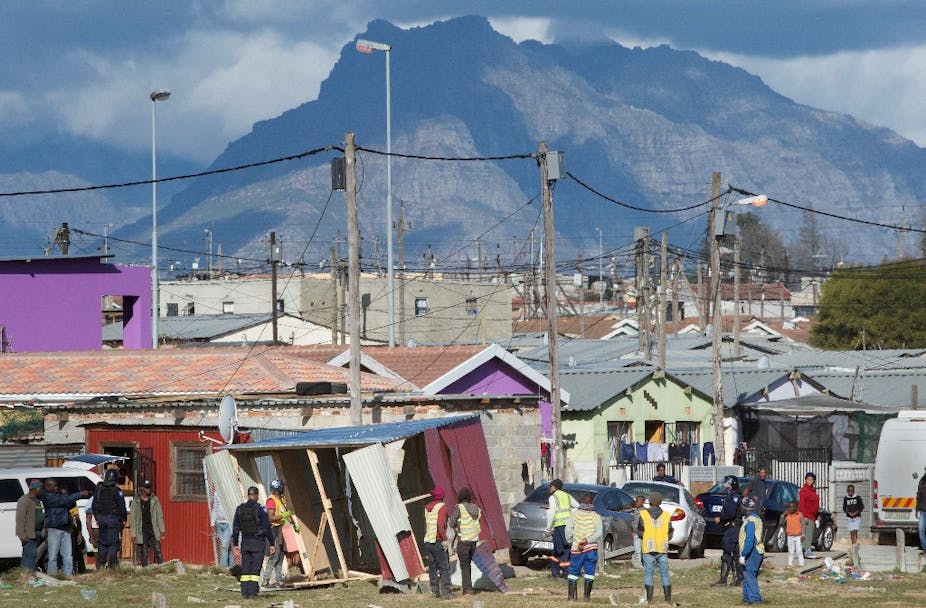South African cities are among the most unequal and segregated in the world. In an effort to address chronic housing shortages, the government has delivered more than 3.5 million free homes since 1994. While the programme has been successful, it has also perpetuated spatial divisions because of the peripheral location of most projects.
To reverse this trend, the government launched a social-housing policy in 2006 to boost affordable rental accommodations in well-located urban areas. In a study financed by European Commission, we evaluated some of the impacts of this programme, revealing mixed results.
Post-apartheid housing policy
Housing was a cornerstone of South Africa’s post-apartheid efforts to redress the legacies of racial discrimination and segregation. The Reconstruction and Development (RDP, 1994) and Breaking New Ground (2004) programmes provided more than 3.5 million houses for poor black households. However, the focus on free-standing, individually owned units resulted in most new developments taking place on the urban periphery, far from economic and social opportunities.
The policy tended to reinforce spatial divides and economic inequalities. Some beneficiaries sold their houses and decided to rent closer to central cities, even if it meant living in poorer quality, unsanitary buildings or “backyard shacks”. Moreover, despite this massive construction of public housing, supply has fallen far short of demand. Thus, in large metro areas such as Johannesburg, Cape Town and Ekurhuleni, one out of five inhabitants lives in precarious accommodation.

Renewed hope with social rental housing
While the focus of South Africa’s housing policy was on homeownership, social rental housing programmes began as early as 1995. The government made subsidies available to third-sector organisations to build and manage affordable rental accommodation. At the same time, private property developers recovered abandoned, sometimes squatted, buildings, especially in Johannesburg, and converted them into inexpensive rental apartments. From these early initiatives emerged a new social housing policy in 2006, which tied subsidies to the delivery of medium-density rental units in “restructuring zones”, similar to “urban free zones” in France. The goal was to bring working-class black citizens closer to areas with access to economic and social opportunities.
The programme delivered fewer than 2,500 units in its first phase (2008 to 2014) but then accelerated to more than 12,800 units constructed by the end of 2018. This was a considerable improvement, but the number was still below the target of 27,000. Today there are only about 35,000 social-rental units despite huge demand. Among the factors constraining production were subsidies that did not keep pace with inflation, lack of investment in capacity-building of social housing organisations, and weak support across government. Changes in 2017 corrected some of these shortcomings and brought renewed energy and investment to the sector.
Spatial drift of projects
We developed a unique database comprising all social rental housing projects in the country, which we analysed for the seven largest metros. Our study, “The role of social housing in reducing inequality in South African cities”, reveals a spatial drift of projects toward peripheral locations. Between 1995 and 2005, most pilot projects were located within city centres. After the new scheme of 2006, more than half of the projects were still located within city centres or inner suburbs. However, from 2011 onward, a growing number of projects were moving to the outskirts and even to townships, including those where the black population was relegated during apartheid.
The map below shows the distribution of social housing projects in Johannesburg and Ekurhuleni and the periods when they were constructed.

Several factors were behind this spatial drift. The first was the rise of real estate values within the private property market. This meant that social housing institutions could no longer find central land at affordable prices. The second was the stagnation of government subsidies. The third was that very few public land parcels were made available for social housing projects.
Do tenants experience upward mobility?
Social housing aims to promote social and racial mixing by targeting households that earn between R1,500 and R15,000 per month. A survey of 10 social housing projects showed that a quarter of the tenants received less than R2,500 per person per month which is close to the poverty line. Rent level are distributed according to income levels, but inflation and rising utility costs make them increasingly unaffordable to poor households, heightening the risk of evictions.
Most tenants in the surveyed projects previously lived within a 5km radius of the project, suggesting that urban restructuring and racial integration have been limited (see graph). Greater racial mixing has been difficult to achieve because of neighbourhood segregation, and was not a major expectation for residents, according to opinion surveys. Social integration, as measured by income, was also modest.

Interviewed tenants benefited from the lower rental charges, which can be much less than the private market. Another benefit is the perception of better safety in the generally secure and institutionally managed complexes. The buildings are often equipped with protection systems and monitored by a guard. Collective facilities are set up such as computer facilities, childcare or secure playgrounds for children (photo). Social development programmes such as healthcare and professional training are also offered. The feeling of safety usually stops at the exit and does not continue into the immediate neighbourhood.
While social housing has impacted positively on households, benefits related to employment, education and access to opportunities appear to be modest rather than transformative. Considerable differences exist between projects depending on their location and the social housing organisation managing the complex.
As South Africa’s social housing policy has arguably ambitious objectives, monitoring and regular impact assessments are needed to develop a stronger evidence base about the impact of projects on household mobility. Specific attention should be paid to adequate financing and making well-located land available, including reforming “restructuring zones”, which have tended to cover the whole metropolitan area.



